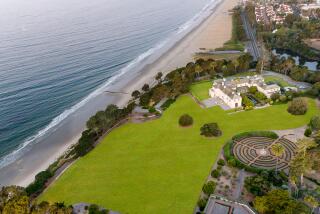A 12th-Century puzzle on the Dixie Highway : A funny thing happened on the way to Hearst Castle, or, how a Spanish cloister jigsaw ended up in Miami.
- Share via
NORTH MIAMI BEACH — In the film classic “Citizen Kane,” various and sundry items of art and memory are found among the treasures of Xanadu--the fictional version of William Randolph Hearst’s castle--in the wake of the media magnate’s death.
But a real-life look at one of Hearst’s Brooklyn warehouses at the same time might have revealed something stranger even than a boy’s beloved sled: a complete 12th-Century Spanish monastery, packed in crates.
A funny thing happened to the monastery of St. Bernard de Clairvaux on the way from Segovia, Spain, to San Simeon, Calif., where it was destined to become a cabana surrounding Hearst’s swimming pool. After a quarter-century detour to Brooklyn, the stone cloister landed in Miami, where it has become a little-known oasis of serenity amid the sun-blasted glitz.
St. Bernard de Clairvaux is a compact architectural gem, incongruously surrounded by strip and mega-malls. Hidden from the street by walls, thick vegetation and a gate, it is largely overlooked by visitors and natives alike. Soft breezes and the taped chants of Benedictine monks waft through the arched corridors that surround the central plaza.
On one side of the compound are formal hedges. On another is a grove of gnarled, ancient banyans, cabbage palms, banana trees and towering Australian pines, shading the ivy-covered ground. Strolling the grounds and the cloister, the feeling is of being in a place out of time.
The monastery--complete with fake monks--is briefly showcased in Goldie Hawn’s recent movie “Crisscross.” Keith Carradine, who plays Hawn’s estranged husband, works as a gardener at the cloister. Set directors had to make the garden look bigger than it really is.
At one point, Hawn’s character asks Carradine--a traumatized former bomber pilot who destroyed a children’s hospital during the Vietnam War--whether he has found peace and serenity at the monastery.
“It makes sense for me here,” he answers.
The monastery was purchased in Spain in 1925 by Hearst’s agents, then scouring Europe for artwork to stock the estate. It was blueprinted, dismantled, crated and shipped to a Brooklyn warehouse. However, after a hoof-and-mouth epidemic broke out in Spain, U.S. agriculture officials feared that the hay used to cushion the blocks was contaminated, so they impounded all 11,000 crates. By the time the hay was burned and the government released the monastery, the stock market had crashed and Hearst had lost interest, leaving the cloister to languish in the warehouse until 1952, a year after his death.
Two Florida promoters bought the monastery (and other Hearst treasures on the three floors of the warehouse) at auction and invested 19 months and $1.5 million to reconstruct it on the site of an old nursery on Dixie Highway. Life Magazine called it “The World’s Largest and Most Expensive Jigsaw Puzzle,” involving 36,000 stones, which, although individually numbered, had not been repacked in the same crates after the hay was burned.
By 1964, the monastery had failed as a tourist attraction, but the cloister was saved from demolition by a $400,000 donation from a philanthropist who gave the property to the local Episcopal diocese, which turned it into a parish church. The congregation now numbers about 250 families and has a day care center.
“People come here for the peace,” said the Rev. Bruce Bailey, not distinguishing between the cloister, which is on the National Register of Historic Places, and the shaded five-acre grounds along a canal.
Only 10,000 tourists a year find the monastery, Bailey said, mainly because the church doesn’t do any advertising and “we’re not on the way to anywhere,” too far off the main line of other tourist attractions and hidden from the street by the foliage and an ornate gate. Latina brides come to have pictures taken in a setting as close to old Spain as available. At 850 years, St. Bernard’s is one of the oldest Spanish churches in this hemisphere.
Francois Bucher, a professor of art history at Florida State University, says that in terms of medieval architecture, St. Bernard de Clairvaux “is probably the second most important object in this country, after the Cloisters in New York,” illustrating the transition from Romanesque to Gothic.
A frequent visitor to the monastery, Bucher says it “is absolutely one of the very best medieval reconstructions in the country--and very surprising on Dixie Highway.” The atmosphere “gives you a sense of the actual history . . . of being in a monastery.”
Bucher calls it typical of the early Cistercian order and notes that it was built to last: One of its three surviving European sisters now serves as a maximum security prison in France, and another, later version from the 13th Century can be found on the banks of the River Boyle in Ireland.
More to Read
Sign up for The Wild
We’ll help you find the best places to hike, bike and run, as well as the perfect silent spots for meditation and yoga.
You may occasionally receive promotional content from the Los Angeles Times.






